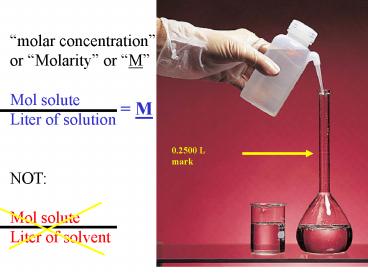molar concentration - PowerPoint PPT Presentation
1 / 30
Title:
molar concentration
Description:
With buret. Calculated. mol NaOH. Liter of solution. 1 mol H2SO4. 2 mol NaOH ... With buret. Calculated. 0.003400 mol. mol NaOH. Consumed in. neutralization. 0. ... – PowerPoint PPT presentation
Number of Views:111
Avg rating:3.0/5.0
Title: molar concentration
1
molar concentration or Molarity or M Mol
solute Liter of solution NOT Mol solute Liter
of solvent
M
0.2500 L mark
2
Use molarity to convert volume of solution to
moles of solute Mi Vi mol solute Use Mi
Vi Mf Vf to calculate concentrations of
solutions following dilution Use Mi Vi mol
solute and stoichiometry to calculate
concentrations of sample solutions in titration
reactions
3
Add more solvent (Dilution)
Mass of solute does not change!
Mi Vi Mol solute Mf Vf
4
How much 6.0 M HCl is needed to make 50 mL of 10
mM HCl solution?
Mi Vi Mf Vf
(6.0 M HCl) (x L) (0.010 M HCl) (0.050 L)
x L (0.010 M HCl) (0.050 L) 8.3 10-5 L
6.0 M HCl
5
How much 6.0M HCl is needed to neutralize 2.3
liters of 0.15M NaOH?
HCl(aq) NaOH(aq) NaCl(aq)
HOH(l)
acid base salt
water
How much 6.0M HCl should be added such that the
mol of H(aq) mol -OH(aq)? (why focus on
H(aq) and OH(aq)?)
6
- Three general classes of chemical reactions
- Precipitation reactions
- Ex geology, heavy metal analysis
- Solid formation, ionic bonds formed/broken
- 2) Acid/base reactions
- Ex many biochemical reactions,
- proton transfer, generally polar covalent bonds
formed/broken - 3) Oxidation/Reduction (redox) reactions
- Ex batteries, metabolic energy production
electron transfer, ionic and/or covalent bonds
formed/broken
7
Balanced Molecular Equation
Soluble ionic compounds dissociate completely
into their constituent ions, as shown more
clearly in the equation below
Complete Ionic Equation
8
Precipitation Reactions Net Ionic Equations
- Write (balanced!) molecular equation first
- Reaction products swap cations and anions
- Predict solubility (using Solubility rules)
- Write complete ionic equation next
- (s) or (g) or (l) compounds dont ionize
- (aq) compounds do ionize
- ion subscripts in molecular equation become
coefficients in complete ionic equation! - Write net ionic equation next
- cancel spectator ions
- The net ionic equation is a simplified
form of the complete ionic equation
9
Stoichiometry and ion dissociation
Na2CO3(aq) MgBr2(aq)
If the concentration of Na2CO3 (aq) 0.27 M,
what are the concentrations of Na (aq) and CO32-
(aq)?
10
Stoichiometry and ion dissociation
Na2CO3(aq) MgBr2(aq)
If the concentration of Na2CO3 (aq) 0.27 M,
what are the concentrations of Na (aq) and CO32-
(aq)?
Complete Ionic Equation
2Na1(aq) CO32-(aq) Mg2(aq) 2Br1-(aq)
SUBSCRIPTS for ions in the chemical formula (in
the Molecular equation) become COEFFICIENTS for
those ions in the Complete Ionic equation.
11
Example Problem 4.37 (b) page 168
Balanced Molecular Equation
12
Solubility Rules Table 4.1
13
Example Problem 4.37 (b) page 168
Balanced Molecular Equation
Complete Ionic Equation
2Na1(aq) CO32-(aq) Mg2(aq) 2Br1-(aq)
2Na1(aq) 2Br1-(aq) MgCO3 (s)
14
Example Problem 4.37 (b) page 168
Balanced Molecular Equation
Complete Ionic Equation
2Na1(aq) CO32-(aq) Mg2(aq) 2Br1-(aq)
2Na1(aq) 2Br1-(aq) MgCO3 (s)
Net Ionic Equation
15
Mi Vi Mol solute Mf Vf
Dilution of a given solution does not change the
mass of the solute present in the container
thus, Mol solute remains constant
Mi Vi constant Mf Vf
Mi Vi Mf Vf
16
(No Transcript)
17
How much 6.0M HCl is needed to neutralize 2.3
liters of 0.15M NaOH?
HCl(aq) NaOH(aq) NaCl(aq)
HOH(l)
acid base salt
water
How much 6.0M HCl should be added such that the
mol of H(aq) mol -OH(aq)?
18
Titration
34.00 mL of 0.1000 M NaOH is required to titrate
a 25.00 mL sample of H2SO4 to the endpoint. What
is the molar concentration of H2SO4 in the sample?
Stoichiometry not 11 !!!
19
Titration Lab 11/3, 11/7
Before equivalence point
At equivalence point
After equivalence point
20
2NaOH(aq) H2SO4(aq) Na2SO4(aq)
2H2O(l)
L of NaOH(aq) required to get to endpoint
mol NaOH Consumed in neutralization
Known
Measured With buret
Calculated
21
2NaOH(aq) H2SO4(aq) Na2SO4(aq)
2H2O(l)
L of NaOH(aq) required to get to endpoint
mol NaOH Consumed in neutralization
Known
Measured With buret
Calculated
0.003400 mol mol NaOH Consumed in neutralization
0.001700 mol mol H2SO4 present in initial sample
From chemical equation
22
Calculated
Molarity of H2SO4 in the original sample
Known
23
Molarity of H2SO4 in the original sample
0.001700 mol H2SO4 in sample
0.02500 L initial sample
Concentration of H2SO4 in the original sample
0.06800 M H2SO4
24
strong acid
weak acid
25
Weak Acids
Acetic acid CH3CO2H Citric acid C3H4O(CO2H)
3 Benzoic acid C6H5CO2H
26
non-conducting solution
conducting solution
27
electrical current flows in solutions that
contain freely moving ions
electrical current flows in solutions that
contain electrolytes
electrical current flows best in solutions that
contain strong electrolytes
28
Three classes of chemical reactions 3)
Oxidation/Reduction (redox) reactions electron
transfer, change in oxidation number
Oxidation number a real (ionic compounds) or
hypothetical (molecular compounds,polyatomic
ions) charge associated with an individual atom
in a compound. The oxidation number allows for
electron accounting
29
To Be Memorized Table 4.5 in text p 146
30
(No Transcript)































